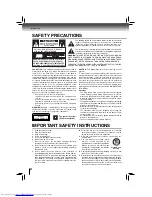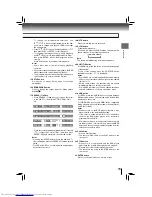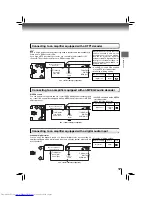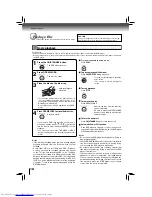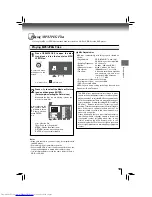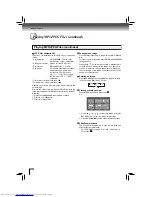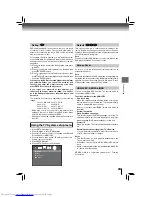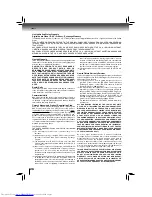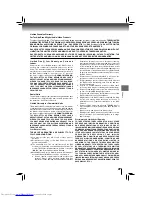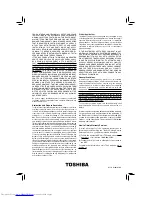
15
Connections
Notes
• If Auto is selected, it follows preference HDMI aspect ratio of TV.
• Refer to the owner’s manual of the connected TV as well.
• When you connect the DVD player to your TV, be sure to turn off the power and unplug both units from the wall outlet before
making any connections.
• If you have a HDMI (with HDCP) equipped monitor or display, you can connect it to this player using a HDMI cable.
• The HDMI connector outputs uncompressed digital video, as well as almost every kind of digital audio that the player is compatible
with, including DVD-Video, Video CD/Super VCD, CD and MP3.
• This unit has been designed to be compliant with HDMI (High Defi nition Multimedia Interface) depending on the component
you have connected. Using a HDMI connection may result in unreliable signal transfers.
• Because HDMI is an evolving technology, it is possible that some devices with an HDMI input may not operate properly with
this DVD player.
• When using HDMI cable, do not connect to other analog video outputs.
• No sound will be output from the HDMI cable if the digital out is not set to PCM.
• HDMI output is only available when the Video output is set to “HDMI”. Otherwise the HDMI button is invalid.
Notes
• Do NOT connect the COAXIAL DIGITAL AUDIO OUT jack of the DVD player to the AC-3 RF input of a Dolby Digital Receiver.
This input on your A/V Receiver is reserved for Laser disc use only and is incompatible with the COAXIAL DIGITAL AUDIO OUT
jack of the DVD player.
• Connect the COAXIAL DIGITAL AUDIO OUT jack of the DVD player to the “DIGITAL (COAXIAL)” input of a Receiver or
Processor.
• Refer to the owner’s manual of the connected equipment as well.
• When you connect the DVD player to other equipment, be sure to turn off the power and unplug all of the equipment from the
wall outlet before making any connections.
• The output sound of the DVD player has a wide dynamic range. Be sure to adjust the receiver’s volume to a moderate listening
level. Otherwise, the speakers may be damaged by a sudden high volume sound.
• Turn off the amplifi er before you connect or disconnect the DVD player’s power cord. If you leave the amplifi er power on, the
speakers may be damaged.
Connecting to Optional Equipment
You can enjoy high quality dynamic sounds by connecting the DVD player to optional audio equipment.
Warning
• When you are connecting (via the COAXIAL DIGITAL AUDIO
OUT jack) an AV decoder that does not have Dolby Digital,
DTS
®
or MPEG2 decoding function, be sure to set “Digital
Output” to “PCM” from the on-screen displays. Otherwise,
high volume sound may damage your hearing as well as the
speakers.
• When playing DTS-encoded discs (DVDs and audio CDs),
excessive noise may be output from the analog audio output
jacks. To avoid possible damage to the audio system, you
should take proper precautions when the analog audio output
jacks of the DVD player are connected to an amplifi cation
system. To enjoy DTS Digital Surround™ playback, an
external 5.1 channel DTS Digital Surround™ decoder system
must be connected to the COAXIAL DIGITAL AUDIO OUT
jack of the DVD player.
Content of the output for each output jack is shown in the following table and differ depending on the On-Screen Display Setting:
* Settings for HDMI output format are performed using the HDMI button on the remote control or HDMI SELECT button on the
front panel.
On-Screen Display Setting
Content of output for each output jack
“Video”
Setting
HDMI Output
Setting
HDMI
Output
Video
Output
Component
Output
Component
(Interlaced)
Invalid
-
Composite
480i
P-Scan
(Progressive)
Invalid
-
Composite
480p
HDMI
480p
480p
Composite
480i
720p
720p
Composite
480i
1080i
1080i
Composite
480i
1080p
1080p
Composite
480i
• For connection to your TV, see “Connecting to a TV” .
• This section uses the following reference marks.
: Front speaker
: Rear speaker
: Sub woofer
: Center speaker
: Signal fl ow


